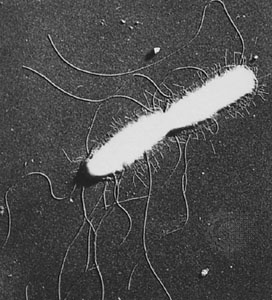Salmonella
bacteria
group of rod-shaped, gram-negative, facultatively anaerobic bacteria in the family Enterobacteriaceae. Their principal habitat is the intestinal tract of humans and other animals. Some species exist in animals without causing disease symptoms; others can result in any of a wide range of mild to serious infections termed salmonellosis in humans. Most human infections with Salmonella result from the ingestion of contaminated food or water.
 Salmonella typhi causes typhoid fever; paratyphoid fever is caused by S. paratyphi, S. schottmuelleri, and S. hirschfeldii, which are considered variants of S. enteritidis.
Salmonella typhi causes typhoid fever; paratyphoid fever is caused by S. paratyphi, S. schottmuelleri, and S. hirschfeldii, which are considered variants of S. enteritidis.Refrigeration prevents bacterial reproduction but does not kill these microorganisms. As a result, many Salmonella can develop in foods, which, when ingested, can result in gastroenteritis.
S. choleraesuis, from swine, can cause severe blood poisoning in humans; S. gallinarum causes fowl typhoid; and S. arizonae has been isolated from reptiles in the southwestern United States.
- larva
- larvacean
- laryngeal cancer
- laryngeal hemiplegia
- laryngitis
- laryngology
- larynx
- La Révellière-Lépeaux, Louis-Marie de
- La Sale, Antoine de
- La Salle
- La Salle, René-Robert Cavelier, sieur (lord) de
- La Salle, Saint Jean-Baptiste de
- La Salle University
- LaSal Mountains
- Las Alpujarras
- Las Bela
- La Scala
- Lascaris, Constantine
- Lascaris, John
- Las Casas, Bartolomé de
- Las Cases, Emmanuel, Count (comte) de
- Lascaux Grotto
- Lascelles Abercrombie
- Las Cruces
- Lascăr Catargiu